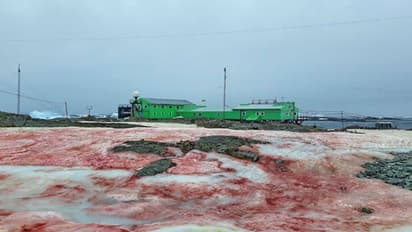After red, Antarctica's snow is turning green

Synopsis
Researchers found that the green snow appears across the Antarctic coast, typically in warmer areas where average temperatures could exceed that of freezing point during summers
Scientists have predicted that in the coming years, the green snow is likely to spread across Antarctica – a result of warmer temperatures and climate change. Presently a substantial part of the southern continent's snow is no longer white, but green, according to reports.
Earlier, because of the algal bloom of Chlamydomonas nivalis, the snow of Antarctica had turned blood red. Algal Bloom has serious consequences on the environment. Algal Bloom decreases the reflection of light from snow and subsequently leads to more absorption.
A report published in Nature Communications, states that the emergence of the green snow is being caused by the propagation of microscopic algae on its surface. Through satellite and field observations, the British Antarctic Survey, alongside researchers from the University of Cambridge have, for the first time, managed to generate a large-scale map of the green algae and project how it may spread in the future.
Researchers found that the green snow appears across the Antarctic coast, typically in warmer areas where average temperatures could exceed that of freezing point during summers. Although microscopic, the algae had spread so much that it was now visible from space.
The team of scientists also found that the green snow was distributed prominently in those areas that mammals and marine birds inhabit, with their excrement acting as a fertiliser. More than 60% of the algal blooms were found beside penguin colonies.
To conduct the study, the researchers looked at satellite data gathered between 2017 and 2019 and combined it with on-the-ground measurements over two summers in Antarctica. That process allowed the scientists to map the microscopic algae as they bloomed across the snow of the Antarctic Peninsula, according to CNN.
Check the Breaking News Today and Latest News from across India and around the world. Stay updated with the latest World News and global developments from politics to economy and current affairs. Get in-depth coverage of China News, Europe News, Pakistan News, and South Asia News, along with top headlines from the UK and US. Follow expert analysis, international trends, and breaking updates from around the globe. Download the Asianet News Official App from the Android Play Store and iPhone App Store for accurate and timely news updates anytime, anywhere.